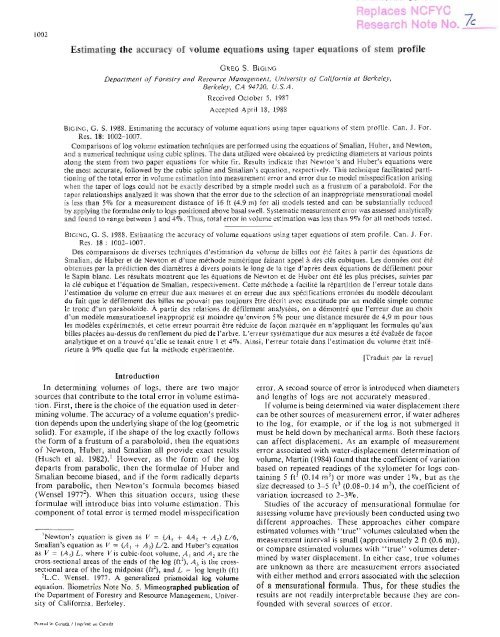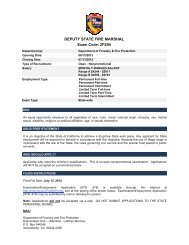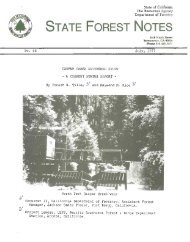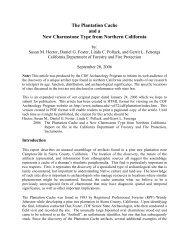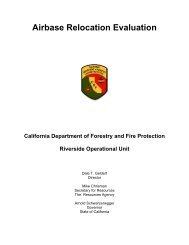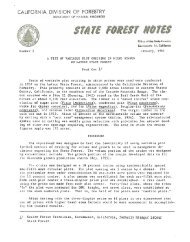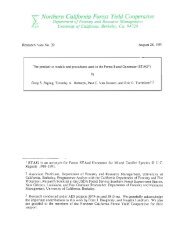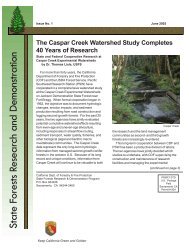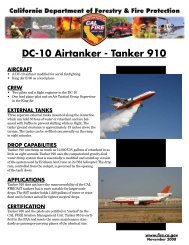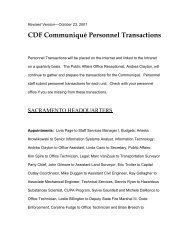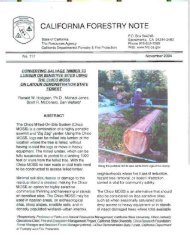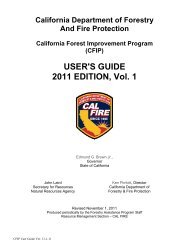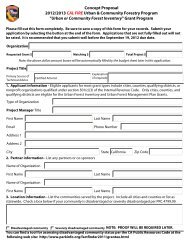Estimating the accuracy of volume equations using taper equations ...
Estimating the accuracy of volume equations using taper equations ...
Estimating the accuracy of volume equations using taper equations ...
You also want an ePaper? Increase the reach of your titles
YUMPU automatically turns print PDFs into web optimized ePapers that Google loves.
1002<br />
Replaces NCFYC<br />
Research Note No. 7c<br />
<strong>Estimating</strong> <strong>the</strong> <strong>accuracy</strong> <strong>of</strong> <strong>volume</strong> <strong>equations</strong> <strong>using</strong> <strong>taper</strong> <strong>equations</strong> <strong>of</strong> stem pr<strong>of</strong>ile<br />
GREG S. BIGING<br />
Department <strong>of</strong> Forestry and Resource Management, University <strong>of</strong> California at Berkeley,<br />
Berkeley, CA 94720, U.S.A.<br />
Received October 5, 1987<br />
Accepted April 18, 1988<br />
BIGING,G. S. 1988. <strong>Estimating</strong> <strong>the</strong> <strong>accuracy</strong> <strong>of</strong> <strong>volume</strong> <strong>equations</strong> <strong>using</strong> <strong>taper</strong> <strong>equations</strong> <strong>of</strong> stem pr<strong>of</strong>ile. Can. J. For.<br />
Res. 18: 1002-1007.<br />
Comparisons <strong>of</strong> log <strong>volume</strong> estimation techniques are performed <strong>using</strong> <strong>the</strong> <strong>equations</strong> <strong>of</strong> Smalian, Huber, and Newton,<br />
and a numerical technique <strong>using</strong> cubic splines. The data utilized were obtained by predicting diameters at various points<br />
along <strong>the</strong> stem from two paper <strong>equations</strong> for white fir. Results indicate that Newton's and Huber's <strong>equations</strong> were<br />
<strong>the</strong> most accurate, followed by <strong>the</strong> cubic spline and Smalian's equation, respectively. This technique facilitated partitioning<br />
<strong>of</strong> <strong>the</strong> total error in <strong>volume</strong> estimation into measurement error and error due to model misspecification arising<br />
when <strong>the</strong> <strong>taper</strong> <strong>of</strong> logs could not be exactly described by a simple model such as a frustum <strong>of</strong> a paraboloid. For <strong>the</strong><br />
<strong>taper</strong> relationships analyzed it was shown that <strong>the</strong> error due to <strong>the</strong> selection <strong>of</strong> an inappropriate mensurational model<br />
is less than 5070for a measurement distance <strong>of</strong> 16 ft (4.9 m) for all models tested and can be substantially reduced<br />
by applying <strong>the</strong> formulae only to logs positioned above basal swell. Systematic measurement error was assessed analytically<br />
and found to range between 1 and 4%. Thus, total error in <strong>volume</strong> estimation was less than 9% for all methods tested.<br />
BIGING,G. S. 1988. <strong>Estimating</strong> <strong>the</strong> <strong>accuracy</strong> <strong>of</strong> <strong>volume</strong> <strong>equations</strong> <strong>using</strong> <strong>taper</strong> <strong>equations</strong> <strong>of</strong> stem pr<strong>of</strong>ile. Can. J. For.<br />
Res. 18 : 1002-1007.<br />
Des comparaisons de diverses techniques d'estimation du <strong>volume</strong> de billes ont ete faites 11partir des <strong>equations</strong> de<br />
Smalian, de Huber et de Newton et d'une methode numerique faisant appel 11des eles cubiques. Les donnees ont ete<br />
obtenues par 1a prediction des diametres 11divers points Ie long de la tige d'apres deux <strong>equations</strong> de defilement pour<br />
Ie Sapin blanc. Les resultats montrent que les <strong>equations</strong> de Newton et de Huber ont ete les plus precises, suivies par<br />
la ele cubique et l'equation de Smalian, respectivement. Cette methode a facilite la repartition de l'erreur totale dans<br />
l'estimation du <strong>volume</strong> en erreur due aux mesures et en erreur due aux specifications erronees du modele decoulant<br />
du fait que Ie defilement des billes ne pouvait pas toujours etre decrit avec exactitude par un modele simple comme<br />
Ie tronc d'un paraboloide. A partir des relations de defilement analysees, on a demontre que l'erreur due au choix<br />
d'un modele mensurationnel inapproprie est moindre qu'environ 5% pour une distance mesuree de 4,9 m pour tous<br />
les modeIes experimentes, et cette erreur pourrait etre reduite de fac;on marquee en n'appliquant les formules qu'aux<br />
billes placees au-dessus du renflement du pied de l'arbre. L'erreur systematique due aux mesures a ete evaluee de fac;on<br />
analytique et on a trouve qu'elle se tenait entre 1 et 4%. Ainsi, l'erreur totale dans l'estimation du <strong>volume</strong> etait inferieure<br />
119% quelle que fut la methode experimentee.<br />
[Traduit par la revue]<br />
Introduction<br />
In determining <strong>volume</strong>s <strong>of</strong> logs, <strong>the</strong>re are two major error. A second source <strong>of</strong> error is introduced when diameters<br />
sources that contribute to <strong>the</strong> total error in <strong>volume</strong> estima- and lengths <strong>of</strong> logs are not accurately measured.<br />
tion. First, <strong>the</strong>re is <strong>the</strong> choice <strong>of</strong> <strong>the</strong> equation used in deter- If <strong>volume</strong> is being determined via water displacement <strong>the</strong>re<br />
mining <strong>volume</strong>. The <strong>accuracy</strong> <strong>of</strong> a <strong>volume</strong> equation's predic- can be o<strong>the</strong>r sources <strong>of</strong> measurement error, if water adheres<br />
tion depends upon <strong>the</strong> underlying shape <strong>of</strong> <strong>the</strong> log (geometric<br />
solid). For example, if <strong>the</strong> shape <strong>of</strong> <strong>the</strong> log exactly follows<br />
to <strong>the</strong> log, for example, or if <strong>the</strong> log is not submerged it<br />
must be held down by mechanical arms. Both <strong>the</strong>se factors<br />
<strong>the</strong> form <strong>of</strong> a frustum <strong>of</strong> a paraboloid, <strong>the</strong>n <strong>the</strong> <strong>equations</strong><br />
<strong>of</strong> Newton, Huber, and Smalian all provide exact results<br />
can affect displacement. As an example <strong>of</strong> measurement<br />
error associated with water-displacement determination <strong>of</strong><br />
(Husch et al. 1982).1 However, as <strong>the</strong> form <strong>of</strong> <strong>the</strong> log<br />
departs from parabolic, <strong>the</strong>n <strong>the</strong> formulae <strong>of</strong> Huber and<br />
Smalian become biased, and if <strong>the</strong> form radically departs<br />
from parabolic, <strong>the</strong>n Newton's formula becomes biased<br />
(Wensel 19772). When this situation occurs, <strong>using</strong> <strong>the</strong>se<br />
formulae will introduce bias into <strong>volume</strong> estimation. This<br />
<strong>volume</strong>, Martin (1984)found that <strong>the</strong> coefficient <strong>of</strong> variation<br />
based on repeated readings <strong>of</strong> <strong>the</strong> xylometer for logs containing<br />
5 ft3 (0.14 m3) or more was under 1070,but as <strong>the</strong><br />
size decreased to 3-5 ft3 (0.08-0.14 m3), <strong>the</strong> coefficient <strong>of</strong><br />
variation increased to 2-3%.<br />
Studies <strong>of</strong> <strong>the</strong> <strong>accuracy</strong> <strong>of</strong> mensurational formulae for<br />
component <strong>of</strong> total error is termed model misspecification assessing <strong>volume</strong> have previously been conducted <strong>using</strong> two<br />
different approaches. These approaches ei<strong>the</strong>r compare<br />
INewton's equation is given as V = (Aj + 4A3 + A2) L/6,<br />
Smalian's equation as V = (Aj + A2) L/2, and Huber's equation<br />
as V = (A3) L, where V is cubic-foot <strong>volume</strong>, Al and A2 are <strong>the</strong><br />
cross-sectional areas <strong>of</strong> <strong>the</strong> ends <strong>of</strong> <strong>the</strong> log (ft2), A3 is <strong>the</strong> crosssectional<br />
area <strong>of</strong> <strong>the</strong> log midpoint (ft2), and L = log length (ft)<br />
2L.C. Wensel. 1977. A generalized prismoidal log <strong>volume</strong><br />
estimated <strong>volume</strong>s with "true" <strong>volume</strong>s calculated when <strong>the</strong><br />
measurement interval is small (approximately 2 ft (0.6 m»,<br />
or compare estimated <strong>volume</strong>s with "true" <strong>volume</strong>s deter<br />
mined by water displacement. In ei<strong>the</strong>r case, true <strong>volume</strong>s<br />
are unknown as <strong>the</strong>re are measurement errors associated<br />
with ei<strong>the</strong>r method and errors associated with <strong>the</strong> selection<br />
equation. Biometrics Note No.5. Mimeographed publication <strong>of</strong> <strong>of</strong> a mensurational formula. Thus, for <strong>the</strong>se studies <strong>the</strong><br />
<strong>the</strong> Department <strong>of</strong> Forestry and Resource Management, University<br />
<strong>of</strong> California, Berkeley.<br />
results are not readily interpretable because <strong>the</strong>y are con<br />
founded with several sources <strong>of</strong> error.<br />
Printed in Canada / Imprime au Canada
Using <strong>the</strong> water-displacement technique, Young et al.<br />
(1967) compared <strong>volume</strong>s <strong>of</strong> nor<strong>the</strong>rn hardwoods and s<strong>of</strong>twoods<br />
in Maine estimated <strong>using</strong> <strong>the</strong> formulae <strong>of</strong> Smalian<br />
and Huber with values obtained by displacement when logs<br />
were immersed in a xylometer. They found that for 8- and<br />
16-ft (2.4 and 4.9-m) logs <strong>the</strong> average errors associated with<br />
Huber's equation (3.5070for 8-ft (2.4-m) logs and - 3.7%<br />
for 16-ft (4.9-m) logs) were consistently smaller and<br />
statistically different from <strong>the</strong> average errors obtained with<br />
Smalian's equation ("" 9.0% for 8- and 16-ft (2.4 and 4.9-m)<br />
logs). As <strong>the</strong> log length decreased to 4 ft (1.2 m), <strong>the</strong> errors<br />
in <strong>volume</strong> estimation decreased, and <strong>the</strong>re were no significant<br />
differences between <strong>the</strong> <strong>volume</strong>s estimated with Huber's<br />
and Smalian's <strong>equations</strong>. Martin (1984) compared <strong>volume</strong>s<br />
<strong>of</strong> 243 eastern hardwood logs (12.3 ft (3.7 m) in length)<br />
estimated with 14 different <strong>equations</strong>, including those <strong>of</strong><br />
Smalian, Huber, and Newton, and compared <strong>the</strong>m with<br />
values obtained by water displacement <strong>of</strong> logs. Martin found<br />
that Huber and Newton's <strong>equations</strong> performed <strong>the</strong> best in<br />
predicting cubic <strong>volume</strong>, followed closely by Smalian's equation.<br />
The biases associated with Huber's, Newton's and<br />
Smalian's <strong>equations</strong> were 2.5,3.9, and 6.9%, respectively.<br />
The mean "true" log <strong>volume</strong> for <strong>the</strong> 243 logs was 6.1 ft3<br />
(0.17 m3).<br />
Ano<strong>the</strong>r approach in evaluating <strong>volume</strong> formulae is to<br />
compare <strong>the</strong> tree <strong>volume</strong> predictions (obtained by summing<br />
<strong>the</strong> <strong>volume</strong>s predicted for logs) with <strong>the</strong> best available prediction<br />
<strong>of</strong> tree <strong>volume</strong>. The best prediction is considered to be<br />
<strong>the</strong> sum <strong>of</strong> <strong>the</strong> log <strong>volume</strong>s calculated when <strong>the</strong> measurement<br />
intervals are as small as possible. For example,<br />
Goulding (1979) examined <strong>the</strong> <strong>accuracy</strong> <strong>of</strong> several standard<br />
mensurational formulae and a spline function3 in<br />
estimating tree <strong>volume</strong>s when <strong>the</strong> interval between<br />
measurements varied. The errors obtained as a percentage<br />
<strong>of</strong> <strong>the</strong> <strong>volume</strong> calculated from <strong>using</strong> a small measurement<br />
interval (approximately 2 ft (0.6 m)) varied by method and<br />
distance between measurements. On <strong>the</strong> average, Goulding<br />
found that a spline curve had an error that was 60% <strong>of</strong> <strong>the</strong><br />
error obtained <strong>using</strong> Smalian's method. Newton's equation<br />
had an error that was, on average, 50% <strong>of</strong> <strong>the</strong> error<br />
associated with Smalian's method. When <strong>the</strong> distance<br />
between measurements was less than 6.6 ft (2 m) all <strong>the</strong><br />
methods tested had small errors (less than 2.3%). However,<br />
as <strong>the</strong> interval between measurements increased, <strong>the</strong> percent<br />
error <strong>of</strong> tree <strong>volume</strong> calculated with Smalian's method<br />
increased rapidly. At a distance <strong>of</strong> 16.4 ft (5 m) <strong>the</strong> percent<br />
errors were 8% for Smalian's equation, 5% for <strong>the</strong> spline<br />
equation, and 4% for Newton's equation. At a distance <strong>of</strong><br />
9.8 ft (3 m) <strong>the</strong> errors were less than one-half <strong>the</strong> errors<br />
obtained at 16.4 ft (5 m).<br />
Thus, assuming an 8- to 16-ft (2.4- to 4.9-m) log, <strong>the</strong>se<br />
research results indicate that <strong>the</strong> total errors encountered<br />
in estimating <strong>volume</strong> are approximately 3-9% for Smalian's<br />
equation, 3-4% for Huber's equation, 1-4% for Newton's<br />
equation, and 2-5% for <strong>the</strong> cubic spline equation. Because<br />
<strong>of</strong> <strong>the</strong> ra<strong>the</strong>r large errors reported in studies <strong>of</strong> <strong>the</strong> <strong>accuracy</strong><br />
<strong>of</strong> Smalian's equation, Husch et al. (1982) recommend that<br />
this equation not be used unless <strong>the</strong> logs are in 4-ft (1.2-m)<br />
lengths. However, because <strong>the</strong>se results include measurement<br />
3A spline function uses a set <strong>of</strong> polynomial segments with<br />
smoothjoinsto createa smoothcurvebetweenspecifieddatapoints<br />
(see Liu 1980).<br />
BIGING 1003<br />
error, <strong>the</strong> effect due to selection <strong>of</strong> a <strong>volume</strong> formula is<br />
overestimated.<br />
Methods<br />
The primary objective <strong>of</strong> this paper is to separately evaluate <strong>the</strong><br />
sources <strong>of</strong> error in <strong>volume</strong> estimation (model misspecification error<br />
and measurement error) by utilizing <strong>taper</strong> <strong>equations</strong> to represent<br />
stem pr<strong>of</strong>ile. With traditional mensurational techniques <strong>the</strong> evaluation<br />
<strong>of</strong> sources <strong>of</strong> error in <strong>volume</strong> estimation cannot readily be<br />
performed. This is because true <strong>volume</strong>s are never known and<br />
estimates <strong>of</strong> "true" <strong>volume</strong>s are confounded with measurement<br />
and model misspecification error, whe<strong>the</strong>r water-displacement<br />
techniques or traditional mensurational formulae are used to<br />
estimate log <strong>volume</strong>s.<br />
Hence, an alternative approach, which supplements traditional<br />
methods, is taken <strong>using</strong> statistical models <strong>of</strong> tree <strong>taper</strong> (pr<strong>of</strong>ile)<br />
to provide "exact" diameters at points along <strong>the</strong> tree stem. With<br />
this technique, known <strong>volume</strong>s can be obtained by integration <strong>of</strong><br />
<strong>the</strong> pr<strong>of</strong>ile equation. Because diameters are specified without error,<br />
<strong>the</strong> confounding <strong>of</strong> sources <strong>of</strong> error can be eliminated. Hence, <strong>the</strong><br />
effect <strong>of</strong> model choice on <strong>the</strong> <strong>accuracy</strong> <strong>of</strong> <strong>volume</strong> estimation<br />
(termed model misspecification error) can be examined in <strong>the</strong><br />
absence <strong>of</strong> measurement error. The effect <strong>of</strong> measurement error<br />
on <strong>volume</strong> estimation can be estimated separately and <strong>the</strong>se two<br />
components combined to form <strong>the</strong> total error in <strong>volume</strong> estimation.<br />
The results are compared with previous research findings.<br />
This approach, however, has an inherent postulate that <strong>taper</strong><br />
<strong>equations</strong> accurately portray <strong>the</strong> form <strong>of</strong> logs and trees. This<br />
premise is plausible but not entirely warranted. Relatively accurate<br />
pr<strong>of</strong>ile <strong>equations</strong> have been developed for many tree species. (cf.<br />
Biging 1984; Bruce et a!. 1968; Demaerschalk and Kozak 1977;<br />
Goulding and Murray 1976;Kozak et a!. 1968; Max and Burkhart<br />
1976), but <strong>the</strong>se pr<strong>of</strong>ile <strong>equations</strong> display some bias at various<br />
relative heights above ground. If, however, <strong>the</strong> relationship is<br />
sufficiently close, this approach will realistically portray <strong>the</strong><br />
influence <strong>of</strong> measurement error and model misspecification error<br />
on true tree <strong>volume</strong>s.<br />
Estimation <strong>of</strong> model misspecijication error<br />
Error in <strong>volume</strong> estimation due to model misspecification was<br />
analyzed by investigating <strong>the</strong> effect <strong>of</strong> <strong>volume</strong> formula4 and log<br />
length (distance between measurements) over 25 size classes for<br />
white fir, Abies concolor (Gord. & Glend.) Lind!. (Iowiana (Gord.»<br />
taken from Biging (1984). The 25 size classes investigated were<br />
composed <strong>of</strong> 2 in. diameter classes from 10to 30 in. (25.4-71.1 cm)<br />
and 20-ft height classes from 50 to 130 f1. (15.2-39.6 m) primarily<br />
falling along <strong>the</strong> main diagonal <strong>of</strong> <strong>the</strong> diameter-height stand table<br />
taken from Biging (1984). Cubic <strong>volume</strong>s were estimated for each<br />
tree <strong>of</strong> a given size class by summing <strong>the</strong> <strong>volume</strong> calculated for<br />
each section5 and were compared with <strong>the</strong> "actual" cubic <strong>volume</strong>s<br />
obtained by integrating a sigmoidal <strong>taper</strong> model (eq. 1) and a<br />
segmented polynomial <strong>taper</strong> model (eq. 2). The results presented<br />
are averaged over <strong>the</strong> 25 size classes. The <strong>taper</strong> <strong>equations</strong> and<br />
coefficients values can be found in Table 1.<br />
Biging (1984) compared <strong>the</strong> diameter predictions <strong>of</strong> model [1]<br />
with those <strong>of</strong> model [2] developed by Max and Burkhart (1978)<br />
and judged by Cao et a!. (1980) to outperform o<strong>the</strong>r models tested<br />
in terms <strong>of</strong> bias, standard error, and mean absolute deviation.<br />
Biging found that models [I] and [2] compared closely in performance<br />
as judged by standard error <strong>of</strong> <strong>the</strong> estimate. The degree <strong>of</strong><br />
4Note that <strong>the</strong> <strong>volume</strong> <strong>of</strong> <strong>the</strong> tip <strong>of</strong> <strong>the</strong> tree was computed<br />
under <strong>the</strong> assumption that <strong>the</strong> tip was conical in shape.<br />
5For Newton's equation <strong>the</strong> log lengths were twice <strong>the</strong> length<br />
<strong>of</strong> <strong>the</strong> logs used with <strong>the</strong> o<strong>the</strong>r <strong>equations</strong>. This insured that <strong>the</strong><br />
distance between measurements was <strong>the</strong> same for all methods used.<br />
This is necessary because Newton's equation requires three<br />
measurements <strong>of</strong> <strong>the</strong> diameter <strong>of</strong> each log, whereas <strong>the</strong> o<strong>the</strong>r<br />
<strong>equations</strong> require only one or two measurements.
1004<br />
TABLE1. Coefficient values for <strong>taper</strong> <strong>equations</strong> [1] and [2] for<br />
white fir, Abies conca/or (Gord. & Glend.) Lind!. (Iowiana (Gord.»<br />
The sigmoid-derived <strong>taper</strong> equation is given as<br />
[I] d = DBH {bl + b2ln[1 - C!!:..JI/3(1 - e-bj/b2)]}<br />
H<br />
where<br />
d = diameter inside bark (in.) at a point h ft above <strong>the</strong><br />
ground<br />
H = total height (ft)<br />
DBH = diameter at breast height (in.)<br />
Values <strong>of</strong> coefficients are as follows:<br />
bj = 1.0933<br />
b2 = 0.3643<br />
The segmented polynomial model is specified by<br />
[2] d2 = bjDBH2(~- 1) + b2DBH2(h22 - 1)<br />
H H<br />
2 h2 2 h2<br />
+ b3DBH(aj - H) Ij + b4DBH (a2 - H) 12<br />
where . h .<br />
Ii = 11f H :::;ai: I = 1,2<br />
I = 0 if ~ > a<br />
I I<br />
H<br />
d, H, and DBH defined as in [1]<br />
Values <strong>of</strong> coefficients are as follows:<br />
bj = - 2.6788<br />
b2 = 1.2778<br />
b3 = - 1.7449<br />
b4 = 75.0475<br />
al = 0.5850<br />
a2 = 0.0734<br />
bias was similar for both models, although <strong>the</strong> levels varied by<br />
relative height and species. However, he found that both models<br />
well represented tree form. Hence, <strong>the</strong> pr<strong>of</strong>iles predicted <strong>using</strong> <strong>taper</strong><br />
<strong>equations</strong> [1] and [2] are assumed to be sufficiently close to actual<br />
tree pr<strong>of</strong>iles to allow an accurate partitioning <strong>of</strong> <strong>the</strong> components<br />
<strong>of</strong> error in <strong>volume</strong> estimation into <strong>the</strong> effect <strong>of</strong> measurement error<br />
and model misspecification error. Models [1] and [2]are both used<br />
as a basis for generating log diameters without measurement error<br />
to investigate model misspecification error. A comparison <strong>of</strong> <strong>the</strong><br />
results from <strong>the</strong>se two models will demonstrate <strong>the</strong> sensitivity <strong>of</strong><br />
results to <strong>the</strong> underlying <strong>taper</strong> surface generated by each mode!.<br />
Estimation <strong>of</strong> measurement error<br />
Measurement errors were assessed algebraically (seeAnalysis and<br />
results) by computing <strong>the</strong> ratio <strong>of</strong> <strong>volume</strong>s predicted with <strong>the</strong><br />
mensurational formulae, assuming consistent measurement error,<br />
to <strong>volume</strong> computed assuming no measurement error. These two<br />
sources <strong>of</strong> error were combined to form <strong>the</strong> total error in <strong>volume</strong><br />
estimation and compared with previous research findings.<br />
Analysis and results<br />
The total error in <strong>volume</strong> estimation comprises measurement<br />
error and model misspecification error. These sources<br />
will be separately analyzed and compared with <strong>the</strong> results<br />
<strong>of</strong> previous studies.<br />
Impact <strong>of</strong> measurement errors on <strong>the</strong> <strong>accuracy</strong> <strong>of</strong> <strong>volume</strong><br />
estimation<br />
The impact <strong>of</strong> measurement error on cubic <strong>volume</strong><br />
estimates can be obtained algebraically by allowing<br />
diameters and lengths <strong>of</strong> logs to vary within specified limits.<br />
For Smalian's equation <strong>the</strong> ratio <strong>of</strong> <strong>volume</strong> that includes<br />
CAN. J. FOR. RES. VOL. 18, 1988<br />
measurement error to <strong>volume</strong> estimated without error is<br />
given as follows:<br />
Stl = K [(D1 + ~D1)2 + (D2 + ~2)2] [L + M]<br />
S<br />
where<br />
K(D? + IYi)L<br />
S - Smalian's cubic foot <strong>volume</strong> without measurement<br />
error<br />
Stl - Smalian's cubic foot <strong>volume</strong> with measurement<br />
error<br />
K<br />
M<br />
7r<br />
(2 X 4 X 144)<br />
= log length measurement error<br />
D1,D2 = <strong>the</strong> diameter measurements at <strong>the</strong> ends <strong>of</strong> <strong>the</strong><br />
log (in.)<br />
After some algebraic calculation, and assuming that <strong>the</strong><br />
terms involving ~? (i = 1, 2) and M are<br />
negligible, <strong>the</strong>n L(Df + IYi)<br />
Stl "" 1 + (2Dl~1 + 2~2~2) + M<br />
S [ (Df + D2) ] L<br />
To estimate <strong>the</strong> mean effect <strong>of</strong> measurement error, a<br />
Monte Carlo simulation approach could be employed after<br />
making distributional assumptions about measurement<br />
errors. However, for this study we need only know <strong>the</strong><br />
ranges in values due to measurement errors to facilitate comparison<br />
with previous studies. A worst-case analysis will<br />
allow establishment <strong>of</strong> ranges within which we can expect<br />
<strong>the</strong> effect <strong>of</strong> measurement error to be bounded. The greatest<br />
measurement error arises when <strong>the</strong>re is a consistent bias<br />
(positive or negative) in measurement. Assuming that<br />
~1 = ~2 = ~, it follows that<br />
[2~(Dl + D2)]<br />
Stl "" 1 + + M<br />
S { [Df + ~] } L<br />
The relative percent change in <strong>volume</strong> estimation <strong>of</strong> logs due<br />
to measurement error is given by<br />
[3] 100 Stl - 100 "" 1O0 [2~(D1 + D2)] + M<br />
[ S ] { [Df + ~] L }<br />
Using a similar derivation for Newton's equation <strong>the</strong> relative<br />
percent change in <strong>volume</strong> estimation <strong>of</strong> logs due to consistent<br />
measurement error is given by<br />
[4] 100 [~] - 100 ""<br />
100 [2~(D1 + 4D3 + D2)] + M<br />
{ [Df + 4D~ + ~] L }<br />
And for Huber's equation <strong>the</strong> relative percent change in<br />
<strong>volume</strong> estimation <strong>of</strong> logs due to measurement error is given<br />
as<br />
[5]<br />
100 [~] - 100 "" 100{ 2D:3 + ~}<br />
Assuming a log length <strong>of</strong> 16 ft (4.9 m), length measurement<br />
error <strong>of</strong> 1/10ft (0.03 m), diameter measurement error<br />
<strong>of</strong> 1/10in. (0.25 em), and a <strong>taper</strong> <strong>of</strong> 1 in. (2.54 em) in 8 ft<br />
(2.4 m), <strong>the</strong>n <strong>the</strong> percent errors vary from approximately<br />
4.50,10for a 6 in. (15.2 em) diameter log to approximately
~ 'I<br />
,. 1 ..- Huber<br />
1:::=1<br />
0 I.--- -- -c<br />
I<br />
.0- Smalian<br />
--c ~- . I r . !<br />
I-I .C. Spline<br />
'.,,c- I<br />
(:11o~<br />
I 16 w<br />
i---~<br />
I<br />
-2<br />
Distance between measurements (ft)<br />
... Newton<br />
FIG. 1. The averagepercent errors in cubic <strong>volume</strong>estimation<br />
<strong>of</strong> trees as <strong>the</strong> distancebetweenmeasurementsvaries,basedupon<br />
a sigmoid-derived<strong>taper</strong> equation (model 1).<br />
1.3(1,70 for a 30-in. (76.2-cm) log.6 There is only 1.8(1,70 error<br />
in <strong>volume</strong> for an 18 in. (45.7-cm) diameter log. It is quite<br />
interesting to note that <strong>the</strong> results <strong>of</strong> this analysis are almost<br />
identical for all three mensurational formulae. Thus, it<br />
appears that <strong>the</strong> effect <strong>of</strong> consistent measurement errors<br />
affects <strong>the</strong>se <strong>equations</strong> equivalently.<br />
The values vary little as <strong>the</strong> stated assumptions are relaxed.<br />
That is, for log lengths <strong>of</strong> 8, 12, and 16 ft (2.4, 3.7, and<br />
4.9 m) and for <strong>taper</strong> rates <strong>of</strong> 0.8, 1.0, and 1.2 in. (2.0,2.5,<br />
and 3.0 cm) per 8 ft (2.4 m), measurement errors do not<br />
change markedly. Assuming an error <strong>of</strong> I/JOin. (0.25 cm)<br />
in diameter measurements may be conservative, and thus<br />
more allowance may be justified. Under <strong>the</strong>se circumstances,<br />
allowing <strong>the</strong> measurement error to double results in approximately<br />
a doubling in <strong>the</strong> error in <strong>volume</strong> estimation, because<br />
<strong>the</strong> approximation to error is directly proportional to <strong>the</strong><br />
magnitude <strong>of</strong> diameter measurement error7 (see eqs. 3, 4,<br />
and 5). The measurement errors could be negative (underestimating<br />
diameter) and <strong>the</strong> effect would be to<br />
underestimate <strong>volume</strong>. In this case, this would simply change<br />
<strong>the</strong> sign <strong>of</strong> <strong>the</strong> values. The case <strong>of</strong> partially countervailing<br />
errors, while not investigated, would tend to lessen <strong>the</strong> effect<br />
<strong>of</strong> measurement error.<br />
For this study, tree <strong>volume</strong> is estimated by summing <strong>the</strong><br />
<strong>volume</strong>s associated with each log (segment) <strong>of</strong> <strong>the</strong> tree. As<br />
trees are composed <strong>of</strong> logs <strong>of</strong> varying diameters, <strong>the</strong> error<br />
due to measurement should be weighted by <strong>the</strong> relative<br />
<strong>volume</strong> <strong>of</strong> <strong>the</strong> tree accounted for by each log. As <strong>the</strong> values<br />
are relatively stable over a wide selection <strong>of</strong> diameters, <strong>the</strong><br />
error in tree <strong>volume</strong> estimation can be approximated by<br />
choosing a range <strong>of</strong> values that encompasses <strong>the</strong> log size<br />
classes <strong>of</strong> interest.<br />
Impact <strong>of</strong> model misspecification error on <strong>the</strong> <strong>accuracy</strong> <strong>of</strong><br />
<strong>volume</strong> estimation<br />
Error in <strong>volume</strong> estimation due to model misspecification<br />
was analyzed by investigating <strong>the</strong> effect <strong>of</strong> <strong>volume</strong> formula<br />
6The approximating formulae presented in eqs. 3, 4, and 5<br />
predict values within 98-100070<strong>of</strong> values calculated with <strong>the</strong> full<br />
expansion.<br />
7Errors in measuring log length exert only a minor effect on<br />
<strong>volume</strong> estimates. for a measurement error <strong>of</strong> 0.1 ft on a 16-ft<br />
log, <strong>the</strong> term 100(M/ L) is only 0.6 and thus contributes only slightly<br />
to <strong>the</strong> calculated values.<br />
BIGING<br />
"<br />
1005<br />
6<br />
- 5<br />
~ C I<br />
0- 4 -I<br />
. I... Huber<br />
.0. Smalian<br />
... Newton<br />
.c, Spline<br />
12<br />
-==e:<br />
l.<br />
16 '.- I<br />
20<br />
1 .<br />
Distancebetweenmeasurements(ft)<br />
FIG.2. The averagepercent errors in cubic <strong>volume</strong>estimation<br />
<strong>of</strong> trees as <strong>the</strong> distancebetweenmeasurementsvaries,basedupon<br />
a segmentedpolynomial<strong>taper</strong> equation (model 2).<br />
and log length (distance between measurements) averaged<br />
over <strong>the</strong> 25 size classes.8<br />
Newton's equation<br />
Wensel (seefootnote 2) has shown that Newton's equation<br />
is exact when <strong>taper</strong> can be expressed as a third-order<br />
polynomial (hereafter termed third-order polynomial form<br />
(TOPF», which is a function <strong>of</strong> distance from one end <strong>of</strong><br />
<strong>the</strong> geometric figure (log). However, when <strong>the</strong> pr<strong>of</strong>ile <strong>of</strong> <strong>the</strong><br />
log cannot be expressed in TOPF, Newton's equation does<br />
not provide exact results. Because models [1] and [2] are<br />
complex and cannot be expressed in TOPF, it follows that<br />
Newton's equation will not provide exact results. Figures 1<br />
and 2 display <strong>the</strong> results <strong>of</strong> <strong>the</strong> average percent error in tree<br />
<strong>volume</strong> estimation (averaged over <strong>the</strong> 25 tree size classes)<br />
as a function <strong>of</strong> distance between measurements obtained<br />
by applying Newton's formula to <strong>the</strong> "exact" diameter and<br />
height values predicted with models [1] and [2]. It is evident<br />
that for any distance between points investigated (4-20 ft<br />
(1.2-6.1 m», Newton's equation is virtually unbiased for<br />
<strong>taper</strong> equation [1]. Even at a distance <strong>of</strong> 20 ft (6.1 m), <strong>the</strong><br />
bias was less than 0.5(1,70. However, for <strong>taper</strong> equation [2],<br />
Newton's equation was positively biased for all measurement<br />
intervals. At a distance <strong>of</strong> 8 ft (2.4 m), bias was under 1(1,70,<br />
at 16 ft (4.9 m) it was 2.5%, and at 20 ft (6.1 m) it was<br />
3.5%.<br />
If 1-4(1,70, at most, is added for measurement error <strong>the</strong>n<br />
<strong>the</strong> total error in tree <strong>volume</strong> estimation is in <strong>the</strong> range<br />
1.5-4.5(1,70, based on eq. lor 3.5-6.5(1,70based on eq. 2, for<br />
a measurement interval <strong>of</strong> 16 ft. (4.9 m). This is similar to<br />
<strong>the</strong> results obtained by Martin (1984) and Goulding (1979).<br />
Thus, it appears that <strong>the</strong> total error (measurement error and<br />
model misspecification) is in <strong>the</strong> range 1.5-6.5(1,70when<br />
Newton's equation is used. Considering only <strong>the</strong> error due<br />
to model misspecification, results from this study confirm<br />
that when <strong>the</strong>re are departures from form for which<br />
Newton's equation is exact, <strong>volume</strong> estimation is biased<br />
when standard log lengths are used. For both models tested,<br />
<strong>the</strong>re was less than 2.5(1,70model misspecification error in<br />
estimating tree cubic <strong>volume</strong> for a standard log length <strong>of</strong><br />
16 ft. (4.9 m).<br />
8The effect <strong>of</strong> size (DBH) is not presented herein because, with<br />
a minor exception, it had no discernible influence on model<br />
misspecification error. The exception to this trend occurred in some<br />
<strong>of</strong> <strong>the</strong> smaller diameter classes in <strong>the</strong> range 10-14 in. for several<br />
<strong>of</strong> <strong>the</strong> <strong>volume</strong> formulae for which <strong>the</strong>re was a small increase in<br />
relative percent error in <strong>the</strong>se classes.
1006 CAN. J. FOR. RES. VOL. 18, 1988<br />
l~~tJ<br />
f:~1 4<br />
g-0.5<br />
0; -1<br />
.it -1.5<br />
-2<br />
\"'"'--! c -2.5 1 1- . "<br />
1<br />
~r-I",<br />
Distance between measurements (ft)<br />
..-Huber<br />
.0. Smalian<br />
..- Newton<br />
.0- Spline<br />
FIG. 3. The average percent errors in cubic <strong>volume</strong> estimation<br />
<strong>of</strong> trees as <strong>the</strong> distance between measurements varies. Estimates<br />
are based upon a sigmoid-derived <strong>taper</strong> equation (model 1),<br />
beginning at breast height to exclude basal swell.<br />
Smalian's and Huber's <strong>equations</strong><br />
For any solid it can be shown algebraically that <strong>the</strong> error<br />
associated with Smalian's equation is twice that <strong>of</strong> Huber's,<br />
and <strong>of</strong> <strong>the</strong> opposite sign to that associated with Newton's<br />
equation (Husch et al. 1982). If <strong>the</strong> geQmetric solid is an<br />
exact frustum <strong>of</strong> a paraboloid <strong>the</strong>n both formulae yield exact<br />
results. As <strong>the</strong> log form departs from parabolic, <strong>the</strong>n <strong>the</strong><br />
<strong>volume</strong>s predicted from both Huber and Smalian's <strong>equations</strong><br />
become biased. As <strong>taper</strong> departs from TOPF, <strong>the</strong>n<br />
Newton's equation is no longer exact, but <strong>the</strong> algebraic relationship<br />
between <strong>the</strong> errors associated with Huber's and<br />
Smalian's <strong>equations</strong> holds relative to Newton's equation for<br />
equivalent log lengths. This cannot be seen directly from<br />
Figs. 1and 2 because results are plotted for intervals between<br />
measurements, not log length. However, for both <strong>taper</strong><br />
models tested, <strong>the</strong> error relative to Newton's equation for<br />
Smalian's and Huber's <strong>equations</strong> is given by a factor <strong>of</strong><br />
- 2 when log lengths are equivalent.<br />
In Figs. 1 and 2 it can be seen that <strong>the</strong> average percent<br />
errors for <strong>the</strong>se two methods are less than 3.5070for ei<strong>the</strong>r<br />
<strong>taper</strong> model for distances up to 12 ft (3.7 m). As <strong>the</strong> distance<br />
increases beyond 12 ft (3.7 m), <strong>the</strong> average percent differences<br />
increase rapidly for Smalian's equation, which has<br />
an averageoverestimate<strong>of</strong> 2.7 and 5.1070for models[1]and<br />
[2] at 16 ft (4.9 m) and 3.7 and 6.8070for models [1] and<br />
[2] at 20 ft (6.1 m), respectively. At 20 ft (6.1 m) Huber's<br />
equation underestimates, on average, by less than 2070and<br />
was approximately 1070at 16 ft (4.9 m) for both models. It<br />
is interesting to note that because Huber's equation is a<br />
function <strong>of</strong> midlog cross-sectional area, it was <strong>the</strong> least<br />
sensitive to changes in <strong>the</strong> underlying <strong>taper</strong> model.<br />
If up to 1-4070is allowed for measurement error for<br />
Smalian's or Huber's equation, <strong>the</strong>n <strong>the</strong> total error in tree<br />
<strong>volume</strong> estimation is approximately 4-7070for model [1]and<br />
6-9070for model [2] for Smalian's equation, and 2-5070for<br />
models [1] and [2] for Huber's equation at a measurement<br />
distance <strong>of</strong> 16 ft (4.9 m). This differs only slightly from<br />
Martin's (1984) and Goulding's (1979) results. Considering<br />
only model misspecification error, results for both <strong>taper</strong><br />
models show less than 5070error in estimating tree cubic<br />
<strong>volume</strong> with Smalian's equation and less than 2070error with<br />
Huber's equation for a standard log length <strong>of</strong> 16 ft (4.9 m).<br />
Spline functions<br />
Spline functions have been successfully used to model<br />
<strong>taper</strong> <strong>of</strong> individual trees (cL Lahtinen and Laasasenaho<br />
1979; Liu 1980; Goulding 1979) and to calculate log cubic<br />
2.5<br />
1.5<br />
~ < , c<br />
1 "' j . ~'=- 0I o!<br />
I~<br />
~<br />
I<br />
--::::.<br />
I '<br />
0<br />
I . I "<br />
..- Huber<br />
.0- Sma1ian<br />
..- Newton<br />
.t]. Spline<br />
1":1 .-1.5 "=-=.,r--r ..I'~" I<br />
Distance between measurements (ft)<br />
FIG.4. The averagepercent errors in cubic <strong>volume</strong>estimation<br />
<strong>of</strong> trees as <strong>the</strong> distance betweenmeasurementsvaries. Estimates<br />
are basedupon a segmentedpolynomial<strong>taper</strong> equation (model2),<br />
beginningat breast height to excludebasal swell.<br />
<strong>volume</strong>s. For a ma<strong>the</strong>matical formulation <strong>of</strong> cubic spline<br />
functions see, for example, Burden et al. (1979). The spline<br />
function for <strong>taper</strong> can be integrated directly to yield cubic<br />
<strong>volume</strong>. Figures 1and 2 display <strong>the</strong> average bias <strong>of</strong> <strong>the</strong> spline<br />
function as distance between measurements increases for<br />
models [1] and [2], respectively. For this study, <strong>the</strong> spline<br />
approximation never exceeds an average <strong>of</strong> 2070for any<br />
distance between data points for eq. 1, but for eq. 2 <strong>the</strong><br />
spline errors were 3.2070at 16 ft (4.9 m) and 4.4070at 20 ft<br />
(6.1 m). Excluding <strong>the</strong> 4-ft (1.2-m) distance, <strong>the</strong> average<br />
ratio <strong>of</strong> spline error to Smalian <strong>volume</strong> error was 57070for<br />
eq. 1 and 62070for eq. 2, which is almost identical with <strong>the</strong><br />
results <strong>of</strong> Goulding (1979).<br />
Assuming <strong>the</strong> same range <strong>of</strong> errors in <strong>volume</strong> estimation<br />
as occurred for Newton's equation (1-4070),<strong>the</strong>n <strong>the</strong> total<br />
error in tree <strong>volume</strong> estimation is less than 3-6070for eq. 1<br />
and approximately 4-7070for eq. 2 at 16 ft (4.9 m), which<br />
is in <strong>the</strong> range <strong>of</strong> errors that Goulding (1979) reported. If<br />
only model misspecification error is considered, <strong>the</strong> bias in<br />
tree <strong>volume</strong> estimation is less than 3.5070for both models<br />
considered for a standard log length <strong>of</strong> 16 ft (4.9 m).<br />
Effect <strong>of</strong> basal swell on model misspecification error<br />
For <strong>taper</strong> pr<strong>of</strong>iles developed from eqs. 1 and 2 <strong>the</strong>re are<br />
only subtle differences in <strong>the</strong> <strong>taper</strong> pr<strong>of</strong>iles.9 However, <strong>the</strong><br />
segmented polynomial <strong>taper</strong> equation (model 2) exhibits<br />
more basal flare than <strong>the</strong> sigmoid-derived <strong>taper</strong> equation<br />
(model 1) and may account for a significant proportion <strong>of</strong><br />
<strong>the</strong> differences in <strong>volume</strong> <strong>accuracy</strong> between <strong>the</strong>se two<br />
models. To test this hypo<strong>the</strong>sis, models [1] and [2] were<br />
reanalyzed <strong>using</strong> only predicted ("exact") diameters at 4.5 ft<br />
(1.4 m) and above to remove <strong>the</strong> effect <strong>of</strong> basal swell. The<br />
results are presented in Figs. 3 and 4.<br />
When Figs. 1and 3 are compared, <strong>the</strong> reduction in model<br />
misspecification error for <strong>the</strong> various mensurational<br />
formulae judged against model [1], which has less basal flare<br />
than model [2], is not pronounced. For Smalian's equation<br />
<strong>the</strong>re was only a reduction a 1070at 16 ft (6.1 m). However,<br />
when Figs. 2 and 4 are compared for model [2], <strong>the</strong>re were<br />
dramatic reductions in model misspecification error for all<br />
mensurational models examined. At 16 ft. (6.1 m) <strong>the</strong> errors<br />
were less than one-third <strong>the</strong> values displayed in Fig. 2 and<br />
did not exceed 1.5070for any mensurational model. These<br />
9Equation 1 predicts more <strong>volume</strong> in <strong>the</strong> lower portion <strong>of</strong> <strong>the</strong><br />
tree bole and is a more "regular" pr<strong>of</strong>ile than that predicted with<br />
eq.2.
esults imply that <strong>the</strong> effect <strong>of</strong> model misspecification is<br />
greatest in <strong>the</strong> basal log in which departures from TOPF<br />
are common and is only moderate for logs from all o<strong>the</strong>r<br />
parts <strong>of</strong> <strong>the</strong> tree.<br />
Conclusions<br />
The total error in log (and tree) <strong>volume</strong> estimation has<br />
two components, one due to measurement error and one<br />
due to model misspecification arising when <strong>the</strong> underlying<br />
shape <strong>of</strong> <strong>the</strong> log departs from a specified geometric shape<br />
such as a frustum <strong>of</strong> a paraboloid. An alternative approach,<br />
which supplements traditional techniques, was taken <strong>using</strong><br />
pr<strong>of</strong>ile <strong>equations</strong> to provide "exact" diameters at points<br />
along <strong>the</strong> tree stem under <strong>the</strong> premise that well-constructed<br />
<strong>taper</strong> <strong>equations</strong> are representative <strong>of</strong> tree and log pr<strong>of</strong>iles.<br />
Unlike traditional techniques, this construct allows <strong>the</strong> two<br />
sources <strong>of</strong> error to be separately assessed.<br />
The results <strong>of</strong> this study indicate that <strong>the</strong> errors in tree<br />
cubic <strong>volume</strong> estimation for white fir resulting from model<br />
misspecification for <strong>the</strong> four methods tested (Smalian's,<br />
Newton's, and Huber's <strong>equations</strong> and a spline function),<br />
while substantial, are less than expected for some models<br />
and are affected by basal swell. When measurements are<br />
taken at a distance <strong>of</strong> 20 ft (6.1 m), all models tested had<br />
an average error <strong>of</strong> less than approximately 70/0, and less<br />
than 5% at 16 ft (4.9 m). Below 12 ft (3.7 m) <strong>the</strong>re was<br />
minor error associated with all four methods «3.5%).<br />
Newton's and Huber's <strong>equations</strong> fared best, but Newton's<br />
was biased as <strong>taper</strong> departed from third-order polynomial<br />
form. As expected, Huber's equation outperformed<br />
Smalian's. The tree <strong>volume</strong> estimation errors associated with<br />
Smalian's equation were smaller than expected, averaging<br />
less than 5% for a standard log length <strong>of</strong> 16 ft (4.9 m). The<br />
cubic spline function and Huber's equation performed very<br />
similarly, with Huber's equation being about 90% or less<br />
<strong>of</strong> <strong>the</strong> value <strong>of</strong> <strong>the</strong> error associated with <strong>the</strong> cubic spline.<br />
Huber's equation, which is a function <strong>of</strong> midlog diameter,<br />
was <strong>the</strong> least affected by differences in <strong>the</strong> underlying <strong>taper</strong><br />
surfaces tested. Thus, it appears that all <strong>of</strong> <strong>the</strong> methods<br />
tested provide relatively accurate estimates <strong>of</strong> cubic <strong>volume</strong><br />
for standard log lengths.<br />
For one <strong>taper</strong> equation, which exhibited a higher degree<br />
<strong>of</strong> basal flare, <strong>the</strong> <strong>accuracy</strong> <strong>of</strong> <strong>the</strong> estimates <strong>of</strong> cubic <strong>volume</strong><br />
was notably increased for Smalian's and Newton's <strong>equations</strong><br />
and for a spline equation when applied to logs above breast<br />
height. This result showed that basal swell can have a<br />
relatively large influence on <strong>the</strong> <strong>accuracy</strong> <strong>of</strong> <strong>the</strong> <strong>volume</strong><br />
estimates. Therefore, when <strong>using</strong> this technique particular<br />
care should be taken to select a <strong>taper</strong> equation that<br />
realistically portrays lower stem pr<strong>of</strong>ile. It also follows that<br />
a considered choice <strong>of</strong> a mensurational model for <strong>the</strong> basal<br />
log is warranted to minimize model misspecification error.<br />
It was estimated that consistent errors in measurement<br />
(over- or under-estimation <strong>of</strong> 1/10in. (0.25 cm) in diameter,<br />
and log length estimation errors <strong>of</strong> VIOft) resulted in 1-40/0<br />
change in <strong>volume</strong> estimation. Therefore, for this study <strong>the</strong><br />
total error in <strong>volume</strong> estimation ranged from approximately<br />
BIGING 1007<br />
2 to 9%, depending on method and distance between<br />
measurements and <strong>the</strong> severity <strong>of</strong> measurement errors.<br />
This technique was shown to provide results in concert<br />
with previous research findings, and also allowed estimation<br />
<strong>of</strong> <strong>the</strong> error associated with <strong>the</strong> choice <strong>of</strong> a mensurational<br />
formula. This methodology is less expensive than traditional<br />
techniques and is easily modified to allow for additional<br />
analysis that would be difficult to achieve without conducting<br />
additional experiments, such as assessing <strong>the</strong> effect <strong>of</strong><br />
a different set <strong>of</strong> log lengths on <strong>the</strong> <strong>accuracy</strong> <strong>of</strong> <strong>volume</strong><br />
formulae.<br />
Acknowledgments<br />
This research was supported in part by <strong>the</strong> Nor<strong>the</strong>rn<br />
California Forest Yield Cooperative and Mcintire-Stennis<br />
Project 3679-MS. Special thanks go to Dr. Ronald L. Giese<br />
for providing computing facilities and support while <strong>the</strong><br />
author was on sabbatical leave at <strong>the</strong> University <strong>of</strong><br />
Wisconsin - Madison. Thanks are also extended to Peter<br />
J. Daugherty for his assistance in computer programming<br />
and processing <strong>of</strong> <strong>the</strong> data during <strong>the</strong> first phase <strong>of</strong> this<br />
project.<br />
BIGING,G.S. 1984. Taper <strong>equations</strong> for second-growth mixed<br />
conifers <strong>of</strong> Nor<strong>the</strong>rn California. For. Sci. 30: 1103-1117.<br />
BRUCE, D., CURTIS, R.O., and VANCOEVERING,C. 1968.<br />
Development <strong>of</strong> a system <strong>of</strong> <strong>taper</strong> and <strong>volume</strong> tables for red<br />
alder. For. Sci. 14(3): 339-350.<br />
BURDEN, R.L., FAIRES, J.D., and REYNOLDS,A.C. 1979.<br />
Numerical analysis. Prindle, Weber and Schmidt, Boston, MA.<br />
CAO, Q.V., BURKHART,H.E., and MAX, T.A. 1980. Evaluation<br />
<strong>of</strong> two methods for cubic-<strong>volume</strong> prediction <strong>of</strong> loblolly pine to .<br />
any merchantable limit. For. Sci. 26(1): 71-80.<br />
DEMAERSCHALK, J.P., and KOZAK,A. 1977. The whole-bole<br />
system: a conditioned dual-equation system for precise prediction<br />
<strong>of</strong> tree pr<strong>of</strong>iles. Can. J. For. Res. 7: 488-497.<br />
GOULDING,C.J. 1979. Cubic spline curves and calculation <strong>of</strong><br />
<strong>volume</strong> <strong>of</strong> sectionally measured trees. N.Z. J. For. Sci. 9(1):<br />
89-99.<br />
GOULDING,e.J., and MURRAY,J.e. 1976. Polynomial <strong>taper</strong><br />
<strong>equations</strong> that are compatible with tree <strong>volume</strong> <strong>equations</strong>. N.Z.<br />
J. For. Sci. 5(3): 312-325.<br />
HUSCH,B., MILLER,C.I., and BEERS,T.W. 1982. Forest mensuration.<br />
John Wiley and Sons, New York.<br />
KOZAK,A., MUNRO, D.D., and SMITH, J.H.G. 1968. Taper<br />
functions and <strong>the</strong>ir application in forest inventory. For. Chron.<br />
45(4): 278-283.<br />
LAHTINEN,A., and LAASASENAHO, J. 1979. On <strong>the</strong> construction<br />
<strong>of</strong> <strong>taper</strong> curves by <strong>using</strong> spline functions. Metsantutkimuslaitoksen<br />
Julk. 95(8): 1-63.<br />
LIU, C.J. 1980. Log <strong>volume</strong> estimation with spline approximation.<br />
For. Sci. 26(3): 361-369.<br />
MARTIN,A.J. 1984. Testing <strong>volume</strong> equation <strong>accuracy</strong> with water<br />
displacement techniques. For. Sci. 30(1): 41-50.<br />
MAX, T.A., and BURKHART,H.E. 1976. Segmented polynomial<br />
regression applied to <strong>taper</strong> <strong>equations</strong>. For. Sci. 22(3): 283-289.<br />
YOUNG,H.E., ROBBINS,W.C., and WILSON,S. 1967. Errors in<br />
<strong>volume</strong> determination <strong>of</strong> primary forest products. In Proceedings<br />
<strong>of</strong> 14th IUFRO Congress, Munich, September 4-9, 1967.Part VI,<br />
Sect. 25. pp. 546-562.


